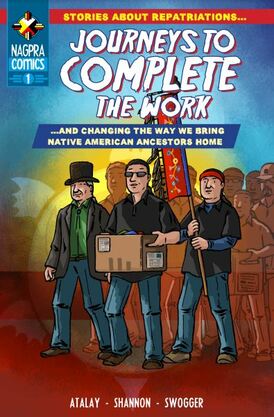
Violence in Comics! Judges squaring off at Thought Bubble 2014 – via: Integra Fairbrook’s Facebook page
I was up in Leeds ten days ago for the Comics Forum conference and the Thought Bubble comics convention. If you’re interested in comics and you’ve never been, mark your calendars for next November: both the conference and the convention are real highlights in the comics year.
Comics Forum is a comics conference that’s been running since 2009. I first started going because they hosted a graphic medicine session in 2011, but have gone back every year since then because they’ve consistently attracted interesting speakers and put together a really diverse programme, whatever the overall theme. This year the theme was “Violence in Comics” – not, you might think, immediately relevant to comics and archaeology; but you’d be wrong. Because there is always such a diversity of speakers attracted to the conference, there was plenty that had both indirect and direct implications for aspects of comics I’m interested in. Some particular highlights:
- Malin Bergstrom discussing Will Eisner’s work on informational comics for the US Army
- Enrique del Ray Cabero on memory, politics and tensions between collective, national and personal experiences of historical violence in graphic novels about the Spanish civil war
- Mihaela Precup and the depiction of survivors, survival and endurance during the Lebanese Civil War in Zeina Abirached’s A Game for Swallows
- Jane Chapman‘s keynote presentation on trench comics produced by soldiers during World War I
- Ian Horton on the social context of representations of violence with reference to British war comics of the 1970s
- Orla Lehane on the quotidian context of extreme and political violence in Troubled Souls (which I remembered from its original publication in Crisis, many years ago)
- Laura A. Pearson on animals and violence in Michael Nicoll Yahgulanaas‘ graphic novel Red, which I referenced in my own paper last year – and in talking with her afterwards, how that violence is mirrored by the political, post-colonial re-claiming of space (gallery, museum, etc.) in the three lives of Red as book, mural and torn-apart-book (and actually, this links in with Olga Kopylova’s really interesting analysis of the effect of media mix in appreciating the “whole story” of manga)
- And finally, a particularly archaeological treat: the panel discussion with Kieron Gillen, Lynn Fotherington and Stephen Hodkinson on the obstacles and pitfalls involved in aiming for a historically accurate depiction of Sparta and Spartans in the comic Three.
At the close of the conference I was invited to take part in the plenary discussion afterwards, which was a good opportunity to try and pick up on various themes running through the conference. Violence as information was something which caught my attention – violence not just as a personal experience, or an event, but violence as a means to communicate something lost, hidden or repressed. Much late-night pub-based discussions ensued on both evenings, catching up with old friends, collaborators and colleagues – and getting to know a whole host of new people as well. I strongly suspect most of the people I know in comics I met through Comics Forum.
And then, to wind down: Thought Bubble on Saturday. Surely the UK’s largest small-press and independent comics convention? At least 3/4 of all the tables were independent or small-press comics creators and/or publishers. Too much good stuff and interesting people to make any kind of full list, but I particularly enjoyed chatting with Lydia Wysocki about travel comics, Oliver East about walking comics, Louise Crosby about comics and poetry, Sarah Burgess about communication in silent comics, and Owen and Jasmine at the Psychedelic Journal of Time Travel who turned out to be archaeologists as well as comic-creators: hurrah!
If I had to pick a favourite comic purchase of the weekend, it would be Lando’s excellent anthology, Gardens of Glass – part Moebius, part Katsuhiro Otomo, part Martin Vaughn-James. The anthology is a collection of short works originally published separately through Decadence Comics, a collective run by Lando and Stathis Tsemberlidis.
As always, great conference – thanks to Ian, Hattie and all who help organise it. And a great convention, too. Thought Bubble just keeps getting better as it keeps getting bigger. And you know what? I’m looking forward to next year already.































